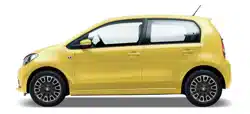Loading ...
Loading ...
Loading ...

Safety
General information on transporting
c
hi
l
dren in the vehicle
Read the additional information carefully
›››
page 17.
Legal regulations and provisions will always
take priority over the descriptions of this in-
struction manual. There are different regula-
tions and provisions for the use of child seats
and their mountings (››› table on page 66).
In some countries, for example, the use of
child seats on certain seats in the vehicle
may be forbidden.
The physical principles and the forces acting
on the vehicle in the event of a collision or
other type of accidents also apply to children
›››
page 51. However, unlike adults and
youngsters, children do not have fully devel-
oped muscle and bone structures. In the
event of an accident, children are subject to a
greater risk than adults of sustaining severe
injuries.
Given that children's bodies are not yet fully
developed, child restraint systems must be
used that are especially adapted to their
height, weight and constitution. There are
laws in force in many countries that indicate
the use of approved seat systems for trans-
porting babies and children.
Only used authorised, approved child seats
that ar
e suitable for the vehicle. Always con-
sult with a SEAT dealership or a Specialised
workshop should you have any doubts.
Specific child seat regulations for each coun-
try (selection)
Child seats must comply with the ECE-R 44
1)
regulation. You can get additional informa-
tion by consulting your SEAT dealership or at
the internet address www.seat.es.
Categorisation of child seats according to
ECE-R 44
Weight cat-
egory
Weight of
the child
Age
Group 0 up to 10 kg
up to approximately.
9 months
Group 0+ up to 13 kg
up to approximately.
18 months
Group 1 9 to 18 kg
approx. 8 months to
3
1
/
2
years
Group 2 15 to 25 kg approx. 3 to 7 years
Group 3 22 to 36 kg approx. 6 to 12 years
Not all children fit in the seat of their weight
gr
oup
. Nor do al
l seats adapt to the vehicle.
Therefore, always check whether the child fits
properly in the child seat and whether the
seat can be installed safely in the vehicle.
Child seats approved under the ECE-R 44 reg-
ulation are fitted with the corresponding ap-
proval symbol. The sign is an upper-case E in
a circle with the identification number below
it.
Use of the child seat on the front pas-
senger seat
Transporting children on the front passenger
se
at
i
s not permitted in all countries. Further-
more, not all child seats are approved for use
on the front passenger seat. Your SEAT deal-
ership has an updated list of all approved
child seats. Only used child seats that are ap-
proved for each vehicle.
The front airbag on the front passenger side
is highly dangerous for a child. The front pas-
senger seat is life-threatening to a child if he
or she is transported in a rear-facing child
seat.
If a rear-facing child seat is secured to the
front passenger seat, an inflating front airbag
can strike it with such great force that severe
or fatal injuries may result
›››
. Therefore,
r
e
ar
-facing child seats must never be placed
1)
ECE-R: Economic Comi
ssion for Europe Regulation.
66
Loading ...
Loading ...
Loading ...
